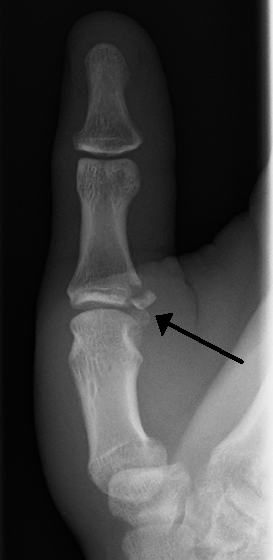Ulnar collateral ligament injury of the thumb
Editor-In-Chief: Prab R Tumpati, MD
Obesity, Sleep & Internal medicine
Founder, WikiMD Wellnesspedia &
W8MD medical weight loss NYC and sleep center NYC
| Ulnar collateral ligament injury of the thumb | |
|---|---|
| Synonyms | Skier's thumb, Gamekeeper's thumb |
| Pronounce | N/A |
| Specialty | Orthopedic surgery |
| Symptoms | Pain, swelling, instability of the thumb |
| Complications | Chronic pain, arthritis |
| Onset | Acute or chronic |
| Duration | Varies |
| Types | N/A |
| Causes | Trauma, repetitive stress |
| Risks | Skiing, hunting, sports |
| Diagnosis | Physical examination, X-ray, MRI |
| Differential diagnosis | Thumb fracture, arthritis |
| Prevention | N/A |
| Treatment | Splinting, surgery |
| Medication | N/A |
| Prognosis | Generally good with treatment |
| Frequency | Common in athletes |
| Deaths | N/A |
An ulnar collateral ligament injury of the thumb, also known as "gamekeeper's thumb" or "skier's thumb," is a common injury to the thumb that involves the tearing or stretching of the ulnar collateral ligament (UCL) at the metacarpophalangeal joint. This ligament is crucial for the stability of the thumb, particularly in pinching and gripping activities.
History
The term "gamekeeper's thumb" was first coined in 1955 by Campbell, who observed this injury in Scottish gamekeepers. The injury was caused by the repetitive stress of breaking the necks of small animals, which led to chronic injury of the UCL. In modern times, the injury is more commonly associated with acute trauma, such as falling on an outstretched hand while holding a ski pole, hence the term "skier's thumb."
Anatomy
The ulnar collateral ligament is located on the ulnar side of the thumb's metacarpophalangeal joint. It provides stability to the joint by preventing excessive lateral movement. The ligament can be injured by a forceful abduction of the thumb, which can occur during falls or direct impacts.
Symptoms
Symptoms of an ulnar collateral ligament injury include:
- Pain and tenderness on the ulnar side of the thumb
- Swelling and bruising around the joint
- Weakness in pinching or gripping
- Instability of the thumb joint
Diagnosis
Diagnosis is typically made through a combination of physical examination and imaging studies. The "valgus stress test" is commonly used to assess the stability of the UCL. X-rays may be taken to rule out fractures, and MRI can be used to evaluate the extent of ligament damage.
Treatment
Treatment depends on the severity of the injury:
- Non-surgical treatment: Mild injuries may be treated with immobilization using a thumb splint or cast for 4-6 weeks, followed by physical therapy.
- Surgical treatment: Complete tears or injuries with significant instability often require surgical repair to restore thumb function. Surgery involves reattaching the ligament to the bone or reconstructing it using a tendon graft.
Prognosis
With appropriate treatment, most individuals recover full function of the thumb. However, delayed treatment or improper healing can lead to chronic instability and arthritis.
See also
Transform your life with W8MD's budget GLP-1 injections from $125.
W8MD offers a medical weight loss program to lose weight in Philadelphia. Our physician-supervised medical weight loss provides:
- Most insurances accepted or discounted self-pay rates. We will obtain insurance prior authorizations if needed.
- Generic GLP1 weight loss injections from $125 for the starting dose.
- Also offer prescription weight loss medications including Phentermine, Qsymia, Diethylpropion, Contrave etc.
NYC weight loss doctor appointments
Start your NYC weight loss journey today at our NYC medical weight loss and Philadelphia medical weight loss clinics.
- Call 718-946-5500 to lose weight in NYC or for medical weight loss in Philadelphia 215-676-2334.
- Tags:NYC medical weight loss, Philadelphia lose weight Zepbound NYC, Budget GLP1 weight loss injections, Wegovy Philadelphia, Wegovy NYC, Philadelphia medical weight loss, Brookly weight loss and Wegovy NYC
|
WikiMD's Wellness Encyclopedia |
| Let Food Be Thy Medicine Medicine Thy Food - Hippocrates |
Medical Disclaimer: WikiMD is not a substitute for professional medical advice. The information on WikiMD is provided as an information resource only, may be incorrect, outdated or misleading, and is not to be used or relied on for any diagnostic or treatment purposes. Please consult your health care provider before making any healthcare decisions or for guidance about a specific medical condition. WikiMD expressly disclaims responsibility, and shall have no liability, for any damages, loss, injury, or liability whatsoever suffered as a result of your reliance on the information contained in this site. By visiting this site you agree to the foregoing terms and conditions, which may from time to time be changed or supplemented by WikiMD. If you do not agree to the foregoing terms and conditions, you should not enter or use this site. See full disclaimer.
Credits:Most images are courtesy of Wikimedia commons, and templates, categories Wikipedia, licensed under CC BY SA or similar.
Contributors: Prab R. Tumpati, MD



